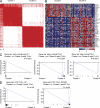ETV6 mutations in early immature human T cell leukemias
- PMID: 22162831
- PMCID: PMC3244026
- DOI: 10.1084/jem.20112239
ETV6 mutations in early immature human T cell leukemias
Abstract
Early immature T cell acute lymphoblastic leukemias (T-ALLs) account for ~5-10% of pediatric T-ALLs and are associated with poor prognosis. However, the genetic defects that drive the biology of these tumors remain largely unknown. In this study, analysis of microarray gene expression signatures in adult T-ALL demonstrated a high prevalence of early immature leukemias and revealed a close relationship between these tumors and myeloid leukemias. Many adult immature T-ALLs harbored mutations in myeloid-specific oncogenes and tumor suppressors including IDH1, IDH2, DNMT3A, FLT3, and NRAS. Moreover, we identified ETV6 mutations as a novel genetic lesion uniquely present in immature adult T-ALL. Our results demonstrate that early immature adult T-ALL represents a heterogeneous category of leukemias characterized by the presence of overlapping myeloid and T-ALL characteristics, and highlight the potential role of ETV6 mutations in these tumors.
Figures





References
-
- Barjesteh van Waalwijk van Doorn-Khosrovani S., Spensberger D., de Knegt Y., Tang M., Löwenberg B., Delwel R. 2005. Somatic heterozygous mutations in ETV6 (TEL) and frequent absence of ETV6 protein in acute myeloid leukemia. Oncogene. 24:4129–4137 - PubMed
Publication types
MeSH terms
Substances
Associated data
- Actions
- Actions
Grants and funding
LinkOut - more resources
Full Text Sources
Molecular Biology Databases
Miscellaneous

